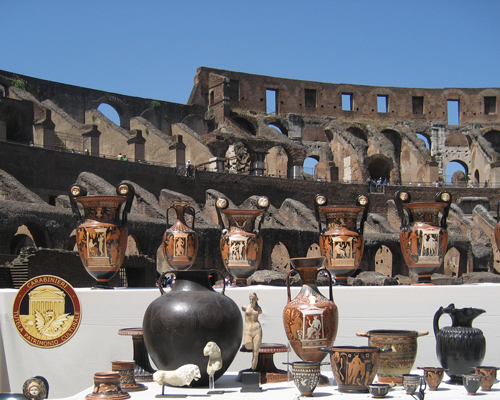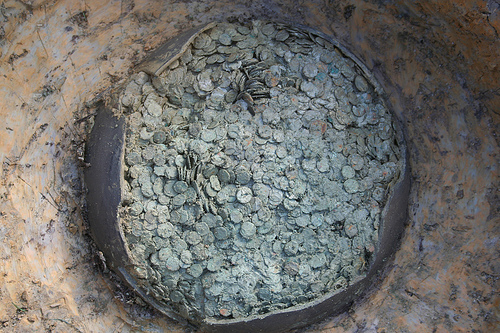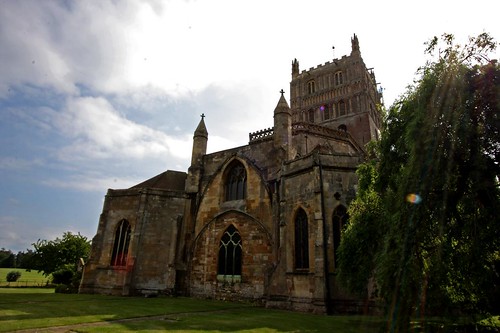More than 300 looted antiquities, estimated to be worth more than EUR15 million, were displayed to the press this morning in Rome, having been repatriated to Italy after they were discovered in a warehouse in Switzerland. It was a scene slightly reminiscent of a Victorian detective novel, in which the robber and his looted candlesticks is unveiled before an impressed gathering of country house guests. Only today’s unveiling took place inside the Colosseum rather than on the pages of a 19th century novel and while there was no criminal present, there was plenty of loot, which consisted of objects such…
-
-
A metal-detector enthusiast has found one of the biggest ever hoards of Roman coins. It is the biggest hoard ever found in a single vessel in Britain, numbering 52,500 Roman coins of varying denominations. The finder was Dave Crisp, who was out with his metal detector in a field near Frome, in Somerset, when his machine alerted him to what turned out to be an earthenware pot full of coins from the third century AD. The coins were contained in a large earthenware jar and altogether weighed 160kg. It is estimated that they would have been worth the equivalent of…
-
A previously unknown Roman villa has been discovered in England by archaeologists excavating an area in preparation for a pipeline to be laid near Tewkesbury. The excavation has uncovered part of a wealthy Roman villa north of Bredons Norton in Gloucestershire. Two burials pre-dating the villa have also been discovered. According to Stuart Foreman, an archaeologist from Oxford Archaeology, the most likely dating of the villa is the late-third to the mid-fourth centuries AD. He said: So far we have discovered a masonry building with plaster walls. It’s not impossible that it’s a shrine, but the most likely explanation is…
-
The July issue, volume 114.3, of the American Journal of Archaeology (AJA) is out now. This month’s issue brings six main articles on subjects ranging from the statues of Manitushu, the culture of late Bronze Age Mycenaean settlements in Thessaly and the legendary ideals of Greek womanhood. While the emphasis is heavily on the Classical period, with some articles on the Bronze Age and the Akkadian empire as well, there is little inclusion of archaeology of the post-Classical world, save for reviews of two publications looking at Medieval pottery and an 11th century shipwreck. The lead article, by Karen Stern,…
-
An unusual Roman burial has been uncovered at a site near Hereford. The female, buried in the first or second century AD, was unusually strong and is buried in a well made coffin. Robin Jackson, senior project manager from Worcestershire council’s Historic Environment and Archaeology Service, was excavating at the site. He said: We’ve been working on the site for three months now and four burials have been found under a building. One of these is slightly unusual, in that it contains the remains of a woman who was very strongly built. She had obviously done hard physical work during…
-
On Tuesday this week public offices in Rome shut down as the city celebrated the feast-day of two of its patron saints, Peter and Paul. So it was an appropriate time for Rome’s archaeological superintendency to announce some of the findings of an archaeological investigation at the Mamertine prison, in which Peter and Paul were allegedly imprisoned during the first century AD. The recent excavation established that the Carcer Tullianum was the site of a religious cult from the fifth century BC, according to Dr Patrizia Fortini, an archaeologist from the Superintendency for Archaeological Heritage in Rome, who worked on…
-
Roman ship-discovery season is in full flow, with several finds and explorations announced in the past week. Yesterday Ansa ran a story about the discovery of a 25-metre merchant ship from the first century AD with its cargo of 500 amphorae containing fruit and vegetables still on board. The ship is said to be in perfect condition and was found south of Panarea, in the group of Aeolian/Lipari islands north of Sicily. The news agency reported that Italy’s Maritime Superintendency and the Aurora Trust, an American foundation, were responsible for the find. Aurora Trust found five wrecks off the Italian…
-
Why were 97 new-born babies buried in the grounds of a Roman villa at Hambleden near High Wycombe, Buckinghamshire, during the third and fourth centuries AD? This is a mystery that has endured for almost a century, since the site was first excavated in 1912 by the naturalist and archaeologist Alfred Cocks. The sheer number of burials led the early 20th century archaeologist to conclude that it was an irregular burial, and that perhaps the babies had been buried there secretly perhaps having been murdered over a period of a century or more towards the end of the Roman occupation…
-
It was reported in the Telegraph earlier this month that the documentary researchers who identified and filmed the source of an aqueduct built by Trajan in 109 AD are battling for access to the site with a local farmer, owner of the land on which the ancient site stands. The film-makers, father and son Mike and Ted O’Neill, visited the site with archaeologists during 2009 and their research was announced in January 2010 (read the full story here). However, since the end of January, the O’Neills and the archaeologists they are working with have not been able to gain access…
-
It was announced at a press conference yesterday in Rome that the oldest known images of the apostles Peter, Andrew and John have been uncovered in one of the city’s Christian catacombs. The images date from the late fourth century AD and were found in the underground chambers of the catacombs of Santa Tecla, in the south of the city near San Paolo Fuori le Mura on via Ostiense. Professor Fabrizio Bisconti, a university professor at lUniversit Roma Tre and an expert in christian and medieval iconography, told me: Last year the earliest image of Saint Paul was discovered at…








